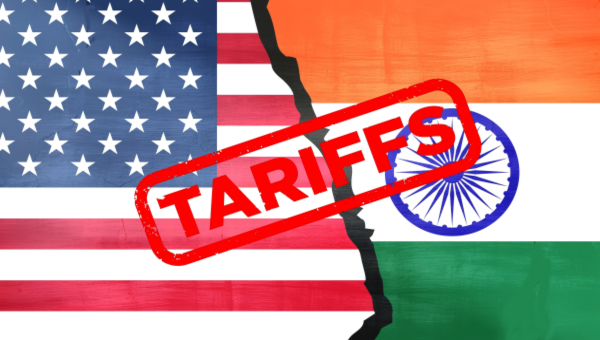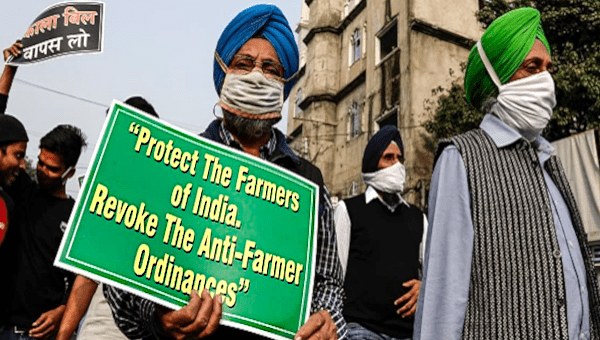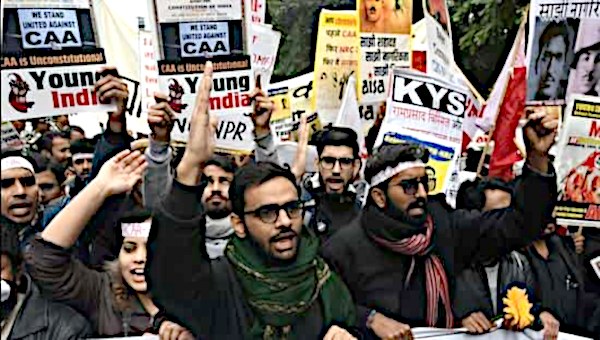Indian Farmers Against Neoliberalism
The scale, intensity and tenacity of on-going protests by India’s peasantry have attracted considerable attention, locally and globally, and the protests are widely hailed as among the most significant recent resistance movements to the machinations of corporate power and interests of big business. I begin by flagging the immediate triggers for the eruption of anger amongst the peasantry, then sketch some core elements of the broader structural-economic context of a period of deep and pervasive agrarian distress. Finally, I sketch some features central to the politics of the movement, and the standoff with an essentially belligerent national/ federal/ union government (as they are used interchangeably), intoxicated by its brute majority and wedded to aggressive neoliberalism.
The key message here is that the regime has been forced to acknowledge a powerful contestation to its agenda although it still remains confident of having its way; however, it seems that the current battle is in an uncertain stretch, but the least that the movement has already achieved is to spotlight the question of the peasantry and overall trajectory of development.
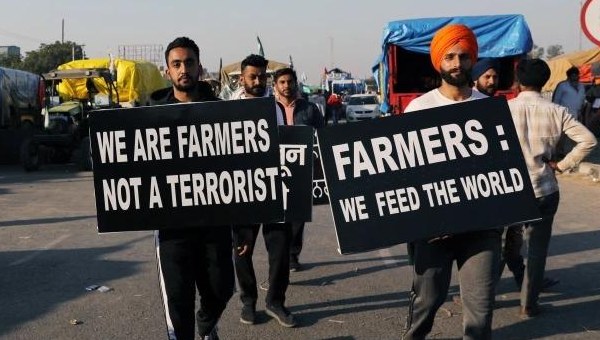
Three Farm Laws
Three farm laws have been the immediate provocation for the huge disaffection among the peasantry: The Farmers’ Produce Trade and Commerce (Promotion and Facilitation) Bill, 2020; The Farmers’ (Empowerment and Protection) Agreement of Price Assurance and Farm Services Bill, 2020; and The Essential Commodities (Amendment) Bill, 2020. The broad intent underlying these laws is not entirely new. For the sake of convenience, let’s call these Law I, II, and III respectively, in the order listed above.
The official raison d’etre for these three legislative changes is to free Indian agriculture, and thereby farmers, from an ‘archaic, over-regulated and inefficient’ system with respect to all major aspects (investment, production, trade etc.) pertaining to the sector, as claimed by the current federal government, led by the Bharatiya Janata Party (BJP). As per this assertion, Indian agriculture has remained trapped in a sub-optimal condition due to an ill-conceived regulatory regime imposed on it by misguided ‘socialist’ governments, robbing the sector of potentially market-driven dynamism through investments, technologies, gains from internal and external trade and so on, which has hurt farmers’ income, discriminated against them disproportionately vis-à-vis other economic groups, and effectively pushed them into ever-growing distress. In short, the Government of India has unabashedly endorsed further freedom to market forces, which effectively means corporate power and agri-businesses, to determine the trajectory and outcomes of Indian agriculture.
The federal government may have sensed the possible discontent about proposed legal changes, but it may not have anticipated its intensity and degree of resentment. Using the COVID-19 pandemic as cover, they were passed as ordinances in June 2020, using the country’s constitutional framework to, ostensibly, address some ‘urgent challenges’; the measure was highly controversial if not dubious. Approximately three months down the road, the government felt emboldened to push it for the Parliament’s approval in a blatantly questionable manner, procedurally, hailing the outcome as a ‘watershed’ for the prospects of Indian agriculture and farmers.
Laissez Faire vs Regulated Capitalism
What are the core objectives of each one of these laws? Abstracting to their basic thrust, Law I removes restrictions on processes, agents and physical procurement for trade in farmers’ produce, as mandated by Agricultural Produce Marketing Committee acts (APMC acts) across a large number of states (provinces), allowing farmers and buyers to trade freely, without any requirement of licenses, commission fees, stock limits and so on, and it also permits transactions through virtual platforms. Note that, since the mid-1960s, the country has had a ‘Minimum Support Price’ (MSP) regime; procurement through APMCs is required to be at announced prices. As it happens, Law I remains silent on this, creating huge apprehensions amongst the farmers that it may be the end of MSP regime, sooner or later. Law II seeks to create an architecture and legal framework for ‘contract farming’ through prior stipulated terms and conditions (including a pre-determined price) between a farmer and a buyer, outside the purview of the existing APMC Acts. Law III reconstitutes the list of ‘Essential Commodities’ by removing several important types of produce, such as cereals, pulses, edible oils, oilseeds, potato and onion, amongst others, most of these being central to food baskets across the country, and removing restrictions on their stocking and trade (including exports). At the most basic level, here is a contestation between two dramatically different perspectives: laissez faire versus regulated capitalism, specifically with respect to agriculture.
There is an on-going stalemate between the government and the farmers’ movement: key demands of the movement are that the three ‘black laws’ must be repealed and the legal guarantee of the MSP must be ensured, along the lines proposed by the National Commission on Farmers almost a decade and a half ago. The government has, in spite of twelve rounds of ‘talks’ with the delegations representing the movement (the latest on 22 January 2021), refused to consider scrapping the contentious laws, or to enact entitlement for the MSP although promising to protect it ‘in writing’. Government shows no serious intent to engage with the movement’s concerns; on the contrary, it has displayed an infinite appetite to discredit the movement through false narratives, misinformation and often being downright abusive.
The BJP and its political allies, with the help of a mainstream media mostly controlled by a few corporates and subservient to the ruling establishment, portray the protests as limited to some rich farmers in pockets of north-western India who are hell-bent on blocking progress, and all those supporting the agitating farmers as various shades of ‘anti-nationals’. But the disquiet of the farmers after the Ordinances were passed in June, 2020, became a mass movement in almost no time in the state of Punjab and resulted in gradual mobilisation of the peasantry across several states of India, notably Haryana, Rajasthan, Madhya Pradesh, Uttar Pradesh, Uttarakhand, Karnataka and Maharashtra, and echoed in many other provinces in the country. Passing the three laws in parliament provided fresh impetus, resulting in the march to the National Capital from Punjab which started on November 25, 2020, led by units of Bharatiya Kisan Union and joined by several constituents of the All India Kisan Sangharsh Coordination Committee (AIKSCC), which has been functioning as a broad front for more than 250 farmer organizations.
Solidarity
As is well-known, these hundreds of thousands of marching peasantry were stopped at the borders of Delhi, with the state’s brute and repressive might on full display. To the huge credit of the movement, it remained resolutely non-violent, and decided to occupy three entry points on the borders of Delhi, to continue their determined opposition to the so-called ‘black laws’. Over time, there has been no waning of farmers’ determination or of solidarity and support from across the country for their movement. In fact, creative strategies of resistance have taken the protests into new territories, geographically and politically. Thus, what emerged as a ‘summer of disquiet’ in Punjab evolved into a ‘winter of discontent’ across north-western India and is now emerging as a gruelling pan-India battle.
The country has not witnessed this scale of mobilization of the peasantry since independence from British colonialism almost 75 years ago, and the unprecedented intransigence of the government in independent India is indeed ironic. It is difficult to foresee how the situation will pan out in the coming months, but the farmers seem resolute in their opposition to what they perceive as facilitating a near-total stranglehold of big business on Indian agriculture.
Law I, as noted earlier, promises easily accessible and barrier-free markets for all farmers for the best possible outcomes for all. Farmers’ key apprehension here, although they endorse the importance of ‘well-functioning markets’, is that a ‘fair and free market’ will be held hostage by trade cartels and agribusiness. It is feared that Law II, popularly called the ‘contract farming law’, will limit and constrain the operation of existing APMC acts to the physical boundaries of the existing mandis (market yards), and thus facilitate a free play for agribusinesses elsewhere. Further, given the huge imbalances in economic power between the corporations and the overwhelming majority of farmers, it is feared that apparent freedom of choice in entering contracts and trading produce to better their lot will be illusory for the bulk of the peasantry. Contrary to official claims, it is felt that the degree of freedom would get curtailed, resulting in worsening economic prospects for farmers such as lower incomes and loss of assets, even leading to new forms of bondages. The major apprehension about Law III is that it would dramatically strengthen speculative forces for critical agricultural commodities, which are likely to depress farmers’ income and hurt many consumers through higher prices, thus worsening food security.
Another widely shared concern is that, if the legal regime of these laws gets into a groove, it is only a matter of time until the existing system of procurement and MSP gets destroyed through neglect and stealth, which would also have grave implications for the Public Distribution System (PDS). Finally, a significant issue with respect to the new legal regime is that it constitutes a serious violation of the federal character of the Indian constitution and a blatant attempt by the current union government to usurp the powers of the state governments. Apart from its outright illegality, a framework imposed from above ignores multiple historico-economic complexities and diversities across states, creates administrative hurdles, and closes political spaces for farmers to deal with the governments they generally consider appropriate for the task.
I have highlighted here two critical overarching apprehensions: first, a huge asymmetry in economic power between agribusiness and the peasantry, in a context where Indian agriculture is being pushed further into a regime of unbridled market forces, nationally and globally; second, within the domestic polity, there is yet another major shove toward centralization that precludes possibilities of progressive interventions, as envisioned and guaranteed by the country’s constitution, at the level of sub-national governments.
A Struggle for the Peasantry’s Survival
A common refrain from advocates of the new farm laws is that the existing administrative-legal dispensation of the APMC (Agricultural Produce Marketing Committee) and other instruments curtailed freedom of choice and access to the market for farmers. This is deeply flawed. Official estimates are that approximately 94% of farmers in the country sell their produce outside the APMC market yards to whoever is a willing buyer, and there is no dearth of them; the core questions have to do precisely with the nature and functioning of the ‘free market’, and whether it can ever assure ‘reasonable returns’ to farming as an economic activity. Farmers argue that the regulated regime, with its APMC, Minimum Support Price (MSP) and so on, have benefitted them for decades in Punjab, Haryana, Rajasthan, Madhya Pradesh, Uttar Pradesh, Chhattisgarh and other states.
Of course, in several states, the network of APMC yards is woefully inadequate, there are serious delays and lapses in procurement, and the existing regulatory regime is characterized by quite a few infirmities. These inadequacies have meant disproportionate distribution of gains across regions, crops and classes, and the marginal and small farmers especially, accounting for more than 85% of cultivators, have gained little from the regulated regime. All these issues have been recognised and articulated by farmers’ movements over time, and hence there has been a demand for universalising procurement at MSP for some time now. The Modi government’s new laws will push Indian agriculture in the opposite direction and expose it to impunity of corporations.
Regulated Regime
Inadequacies notwithstanding, the regulated regime and public policies vis-à-vis agriculture were critical in ensuring a degree of food sufficiency and security in the country. India’s food economy in the late 1960s and ‘70s presented quite a difficult picture, and many had written it off as a basket case and a Malthusian nightmare. A regulated regime, including state-led policies under the so-called Green Revolution (GR) strategy, with priority sector lending, subsidised inputs and extension services coupled with procurement operations, MSP, the Public Distribution System at subsidised prices, and so on, significantly improved the overall agricultural and food situation. Incomes for cultivators were uneven, although substantial segments gained handsomely, and the country as a whole leaped toward at least significant cereal security.
Punjab, Haryana and Western Uttar Pradesh, in particular, were impressive success stories of the regulated regime for most of the period since the early 1970s, and became the granary for the nation. Even recent estimates put procurement of wheat and rice in the country from Punjab and Haryana at around 70%. The Commission for Agricultural Costs and Prices announces MSP for 23 crops currently, but implementation beyond rice and wheat is negligible. However, for these two crops, 75% to 95% of even small and marginal farmers in Punjab and Haryana are able to access MSP, dramatically higher than the all-India averages. Coherence amongst different components of the regulated regime created particularly conducive systems in north-western India for realisation of not only decent output growth, but also assured, wide-reaching income growth. Obviously, the widespread perception that the new laws may deal massive body blows to assured returns from cultivation underlies the huge anger within this region among the peasantry at large, and all those connected with agriculture, including hired farm labour. Even though procurement and the MSP were of limited significance in large parts of the country, farmers everywhere had benefited, in varying degrees, from various components of public policy since the late 1960s, and the Modi government’s new farm laws are viewed by many farmers as abandoning critical support and protection mechanisms for agriculture; hence the resentment against these laws has an almost a pan-Indian character.
Adverse Features
Further, some farmers have already experienced some adverse features of the new legislation. For instance, unregulated procurement through private operators (including through electronic channels) has been widespread and corporates have become increasingly active players in this market in recent years. Similarly contract farming of various hues, with increased presence of corporate houses, has been well documented across several states since the 1990s, including tomatoes and potatoes in Punjab, cotton and onions in Maharashtra, and high-end exotic foods and vegetables from these and other states, yielding questionable outcomes for farmers and leaving the peasantry at the mercy of big business.
Although the Modi government’s farm laws are the immediate trigger for the current agitation by the farmers, it is rooted in a longer history of the structural and policy context. A range of issues intrinsic to the ‘green revolution’ itself, such as increased chemicalization, particular cropping patterns, depletion of water resources and other ecological challenges, have contributed to falling productivity and incomes from cultivation over time, raising serious questions about sustainability of GR driven model of Indian agriculture.
The overall macro-policy regime since the early 1990s has further aggravated already serious threats to Indian agriculture. The most tragic manifestation has been mounting suicides by farmers: officially, close to four hundred thousand in 25 years (likely an underestimate). Two broad factors are critical here: a serious squeeze on fiscal space since 1990, with significant adverse effects in agriculture; and increased exposure to unregulated markets, both domestic and international, and thus to more volatile prices. The result has been mounting costs, falling farm-gate prices, downward pressure on income from cultivation and growing indebtedness – almost three decades of distress, seriously threatening the very survival of the overwhelming majority of the Indian peasantry.
Thus, a massive squeeze on the peasantry has been evident for some time, leading to frequent protests, especially under the Modi government since 2014 due to further assaults on the countryside. For almost five years, both the intensity and frequency of the organized protests have been on the rise. The current tide of resentment sweeping the peasantry needs to be located in this context. As elsewhere, neoliberalism in India has subjected the peasantry and other working people to an economic squeeze by dismantling several components of limited protection that were put in place during the interventionist era. However, a few important provisions were not abandoned entirely during the transition to neoliberalism, although weakened considerably; in agriculture, the MSP and PDS continued to provide a degree of support to both peasant agriculture and food security. Given the brazen apathy of the Modi government over the last few years, and especially the new farm laws, the peasantry fears that whatever protection is left will be snatched away and that Indian agriculture will effectively be taken over by corporate power.
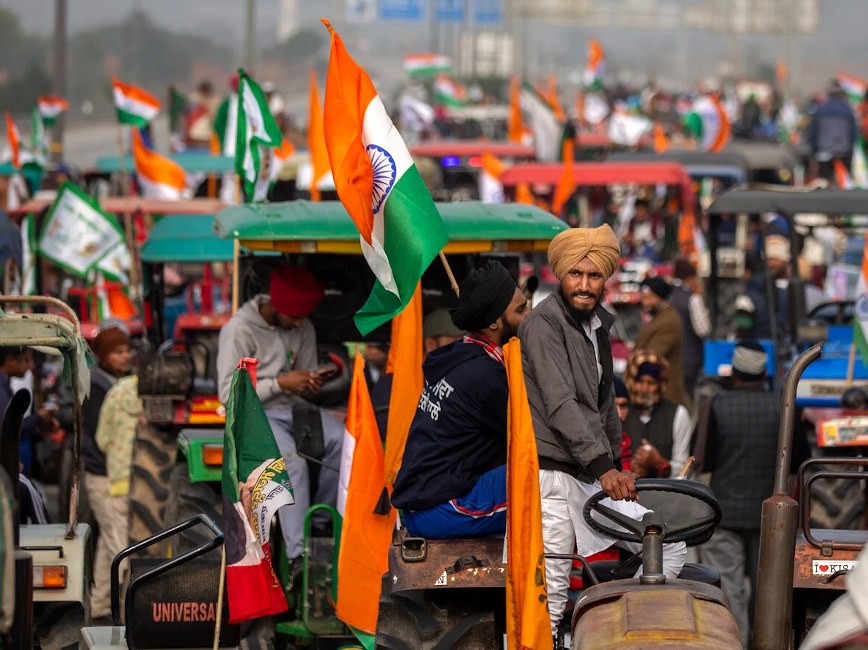
Coordination
The level of coordination among a whole spectrum of farmer unions and organizations, putting aside their differences to work together for a critical minimum agenda, is another remarkable feature of the current agitation. The AIKSCC – a major initiative of farmers’ organizations toward a national platform – came into existence in 2017, soon after five farmers were killed by police in Mandsaur while protesting against some of the farm policies of the then BJP government in the state. The AIKSCC has emerged as a powerful voice of the peasantry, and two of its key demands have been legal entitlement to remunerative prices, and relief from debt. Underlying the common agenda is an understanding that the current agrarian crisis is rooted in the neoliberal policy regime, and a substantive, frontal confrontation with it is necessary.
The AIKSCC currently consists of more than 250 farmer organizations in the country, including the All India Kisan Sabha (AIKS), formed in 1936 and with a membership of more than 15 million farmers spread over several states. The AIKSCC has forged and expanded solidarities amongst farmers in the past few years, profoundly shaped discourses on agrarian distress, and drawn considerable support from several quarters, including political parties. A meeting on 27 October, 2020, between the AIKSCC and several farmer organizations from Punjab and Haryana, decided to intensify the protest against new farm laws under the banner of Samyukt Kisan Morcha (SKM).
Given the diverse bases of the organizations coming together, palpable differences are bound to be there; indeed, some of the contradictions are deep. But going by the experience of recent years and the latest mobilization, it seems to me that the assault of neoliberal policies and concomitant crisis in the countryside, and perceptions of what looms ahead if there’s more of the same, has brought about better critical engagement, and unity of purpose, amongst different shades of farmer organizations.
Exposing agriculture to unbridled operations of the so-called free market leads to a gobbling of the small by the big, pauperization of the peasantry at large, and increased corporate control of the sector. Farmers across classes, everywhere, are increasingly exposed to agribusiness power and impunity. However, international capital, mostly headquartered in the ‘global North’, has had a field day in the South through every possible channel, including predatory capture of land and natural resources. ‘Accumulation through encroachment’ (to use Prabhat Patnaik’s phrase) is hurting agriculture and farmers in the ‘South’ much more dramatically than in the ‘North’ (see Patnaik and Patnaik, 2021 for an elaboration of this argument).
There is overwhelming evidence that the ascendency of neoliberalism has increased farmers’ stress globally. For instance, there is a considerable literature which documents that farm-gate prices, farmers incomes etc., globally, have come under huge pressure in the recent decades (see Magdoff and Tokar, 2010). Countries in the global North pump billions of dollars into direct income support for their farmers and agricultural subsidies. The subsidy support per farmer in the US is estimated to be more than US$60,000 each year. The European Union dishes out close to US$100-billion to its agriculture, approximately half of it as direct income support to farmers. China has become, in absolute terms, the biggest subsidy provider globally (US$212-billion in 2016) (see Kumar 2021).
It is hardly surprising that the movement has been unrelenting in its demands. More than 400 farmers have lost their lives at the Delhi borders alone since the beginning of the sit-in: for government, it is no more than a cold body-count! The struggle against the farm laws is likely to be a long and gruelling one, and farmers seem determined for such a haul. •
References
- Patnaik, U. and Patnaik, P. (2021) Capitalism and Imperialism: Theory, History and Present, New York: Monthly Review Press.
- Magdoff, F. and Tokar, B. eds (2010) Agriculture and Food Crisis: Conflict, Resistance and Renewal, New York, Monthly Review Press.
- Kumar, R. (2021) “Farmers Protests: Agricultural Expert Devinder Sharma Answers Frequently Asked Questions,” The Wire, 17 January.
This article first published on the Global Labour Column website.


